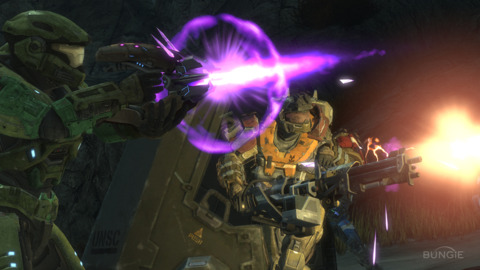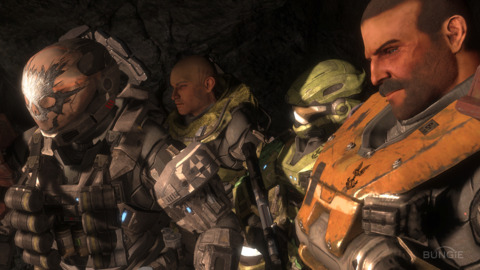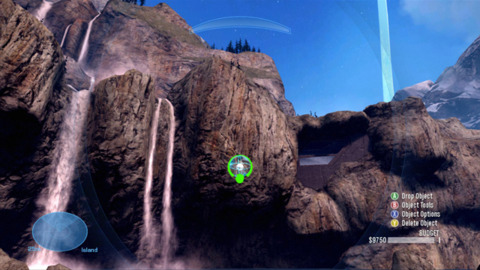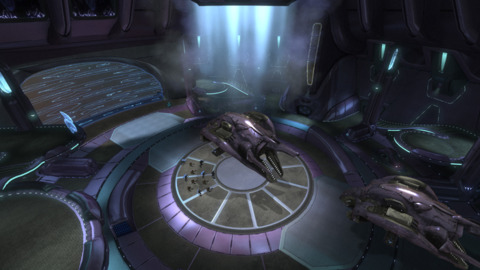
Halo: Reach is a prequel to the first game in the series, providing some perspective on events that take place just before the opening of Halo: Combat Evolved. It also provides some perspective that isn't found in the book upon which these events are based, Halo: The Fall of Reach. So while you'll probably already know that things are about to go very, very bad on the planet called Reach, you don't know the specifics about how the attack went down. The story focuses more on a group of six Spartans called Noble Team, who encounters Covenant forces on the planet, immediately sending the entire world into chaos. You'll play as a Spartan referred to as Noble Six throughout the game. Six's shadowy past paints him as something of a lone wolf bad-ass in the Master Chief mold, but Six is new to the team, so you'll be paired up with and taking orders from the rest of your unit as you work your way from one conflict to the next. Though the constant conflict doesn't leave much time for the other five members of Noble Team to get personal, most of the characters manage to be interesting, which makes the story work well enough to keep it engaging.
If you've played just about any of the previous Halo shooters, you won't be too surprised by what you find in Reach. The pacing, structure, and most of the equipment have popped up in the previous games. Bungie didn't go "reinvent the Assault Rifle" or anything silly like that. And unlike its past game, Halo 3: ODST, Reach returns to a more conventional format, moving you directly from level to level without any sort of hub world. Though you'll often be teamed up with one or more of the other Spartans from your team, the gameplay doesn't really change as a result. They behave just like any other AI in the game, shooting when appropriate and automatically teleporting up to you at checkpoints if you decide to leave them behind. It might have been nice--and would have driven home the unique nature of Noble Team--if those guys were integrated more tightly into the action. The story does take a couple of twists, though, setting up some interesting vehicle sequences and some bits that are slightly more open-ended than Halo games have been, traditionally speaking.

Rushing past those encounters is enabled by the game's new armor abilities. These are slotted and swapped out just like a weapon, though you can hit the left bumper to activate your currently equipped ability. The default ability is a sprint, which is great, especially if you're the sort of person that wishes that Halo had a slightly faster pace. You can't run forever, though. All of the abilities have a meter that drains when activated and takes a bit of time to recharge. In the campaign, you'll occasionally find other armor abilities out in the field, allowing you to swap out the sprint for a jetpack, a cloaking device, a couple of different shield options, and so on. These armor abilities also factor into the game's multiplayer.
OK, multiplayer. It's kind of a big deal in the Halo universe, right? In Reach, the options and abilities have grown quite a bit. Campaign co-op is still there for up to four players and can be played with or without scoring. It's also supported by the game's matchmaking features, allowing you to play through the campaign with strangers. For those of you without a bunch of Halo-loving friends who want to get a team together, this is a terrific addition. Matchmaking has also come to Firefight, the wave-based survival mode introduced in ODST. That's a great enhancement, too, but it's not the only thing going on with Firefight.
The default mode has changed a bit to make it more inviting overall, but it's what you can do with the addition of custom variants that makes Firefight so much more interesting. Much like Halo 3's multiplayer, you can tweak a ton of different things to make modes that feel very different from the default. If you'd like, you can enable generators that must be protected from the incoming Covenant forces. You can set which types of enemies come at you in every wave, or tweak your starting health, or alter damage modifiers on weapons and health... essentially, you can make it completely impossible, mind-numbingly easy, or just about anything in-between. Incidentally, making it incredibly easy is handy if you're the sort of person who wants to get some of Halo: Reach's Firefight achievements without breaking a sweat. The Firefight maps in Reach also feel more interesting than most of the arenas and other maps found in ODST.

Visually, the game looks sharper and has better texture clarity than its predecessors, though the frame rate can get a little unstable, particularly during the game's real-time cutscenes. It's nice that those cutscenes are being rendered on the fly, though, since you're constantly earning credits that can be used to buy various armor add-ons. They're totally cosmetic, but it's neat to be able to pick up new helmets, shoulder pads, chest plates, and so on as you play, and this helps you make your Noble Six a little more personal. You can also purchase additional voices to be used in Firefight mode, and these include the cast of Reach as well as some throwbacks from previous Halo games.

When taken with the appropriate context--namely, that the game's original developer is saying goodbye to the series and passing it off to a new team--Halo: Reach feels like a wholly appropriate stopping point for the series, filling out some more of the relevant fiction that surrounds the core trilogy while building the multiplayer out in such a way that Halo fans will have something to play until whatever's next is ready for release. While I do feel that the formula has worn thin in a few spots, Reach feels like a love letter from the developer to its fans. If you're one of those fans, you should have this game.